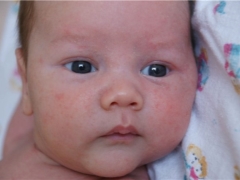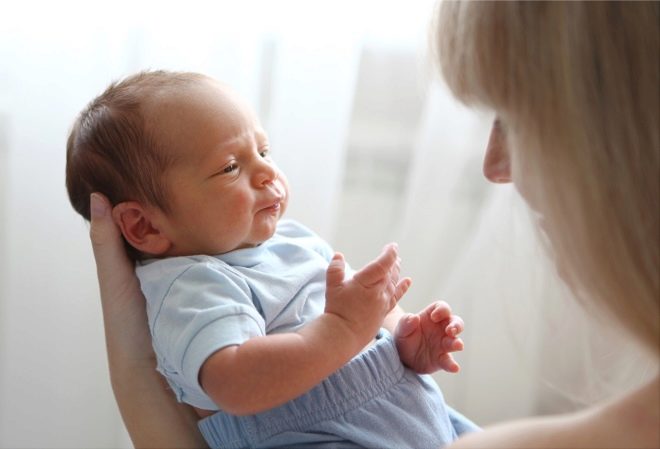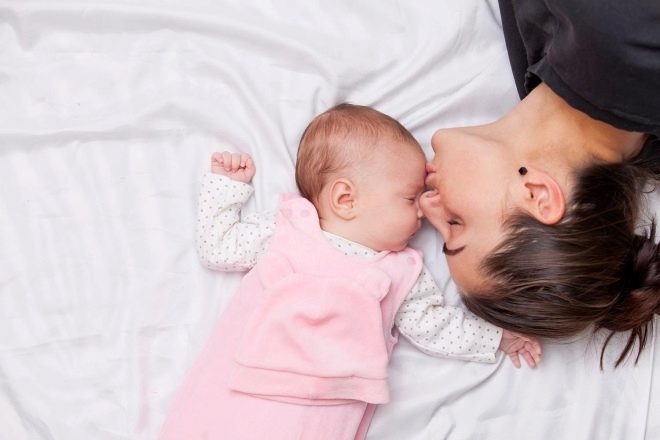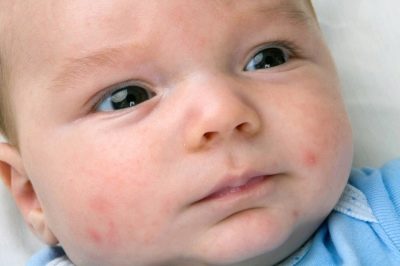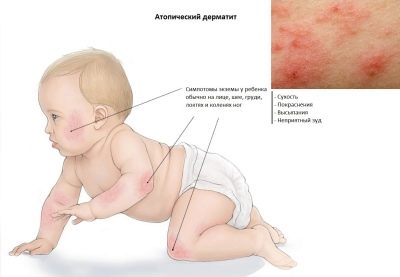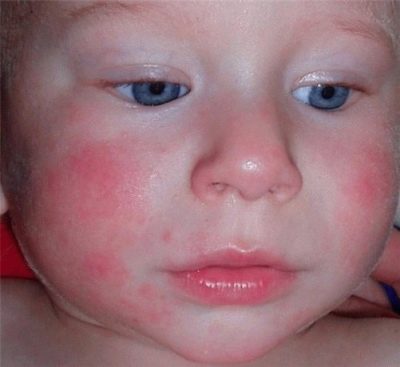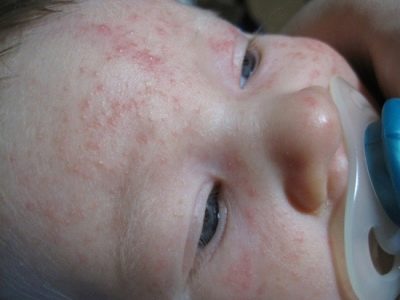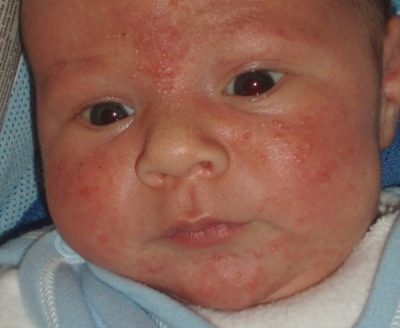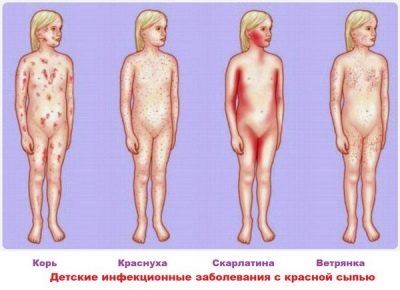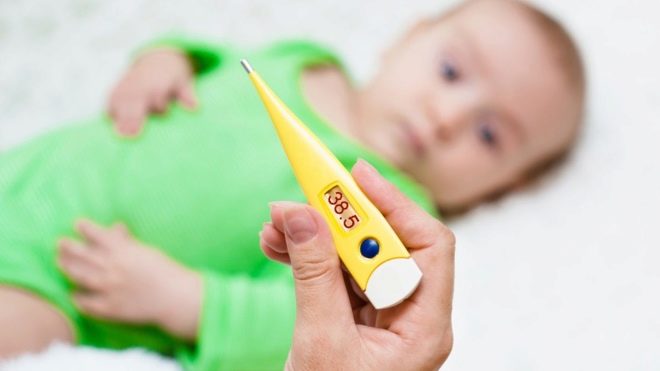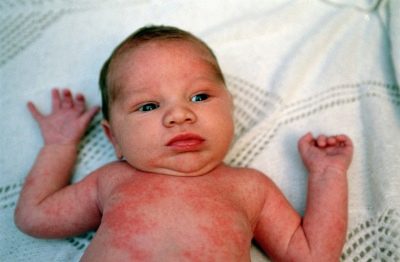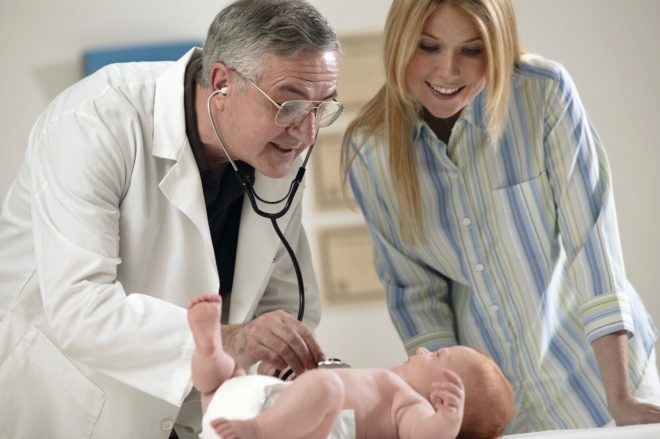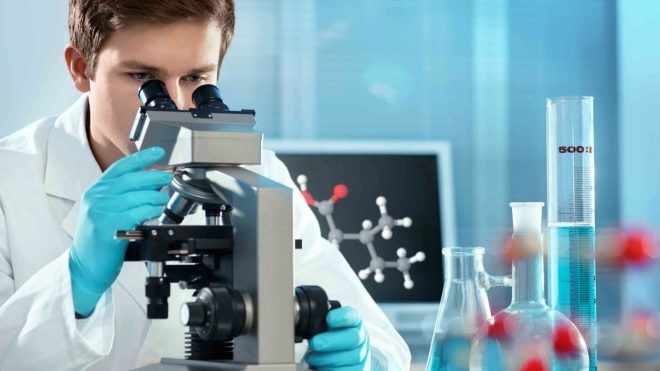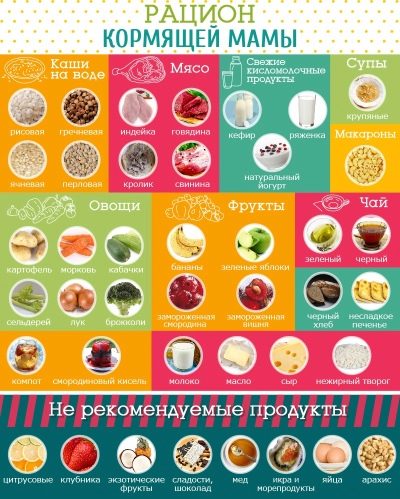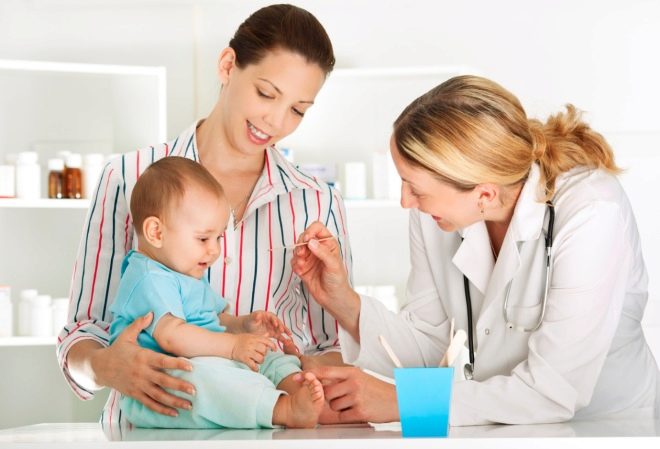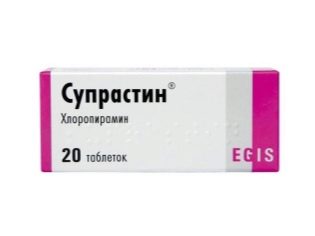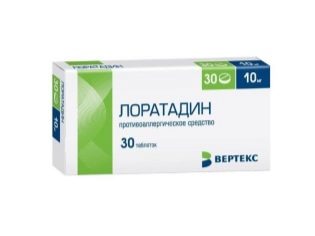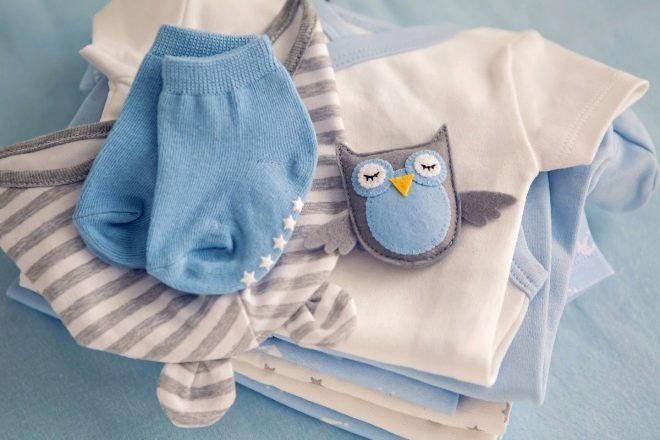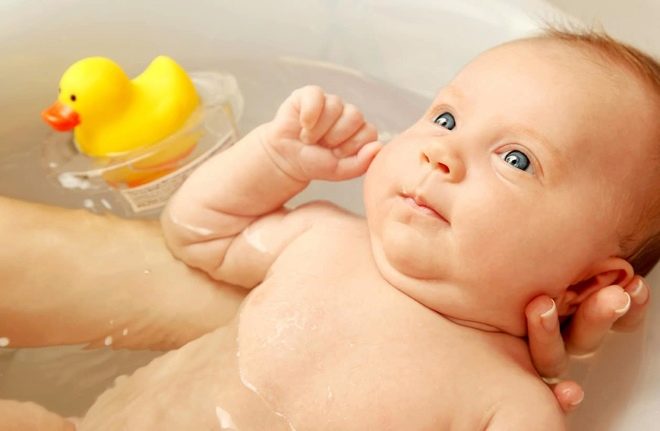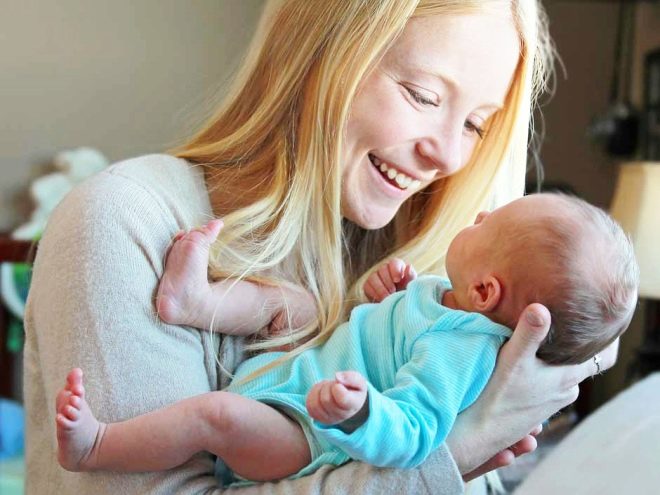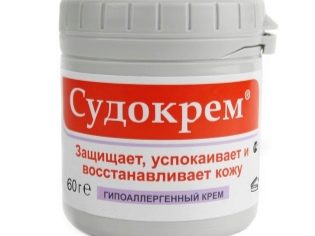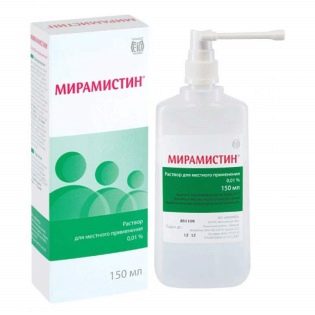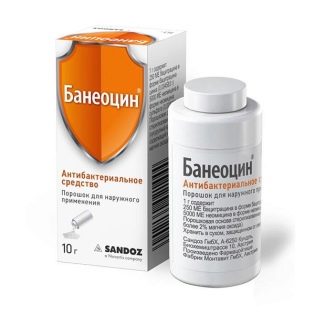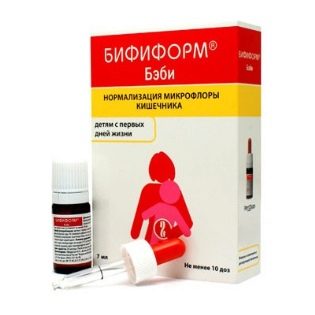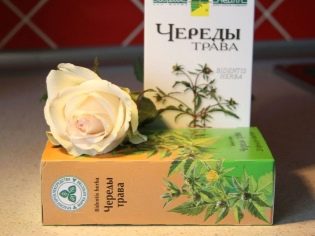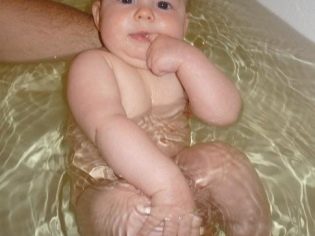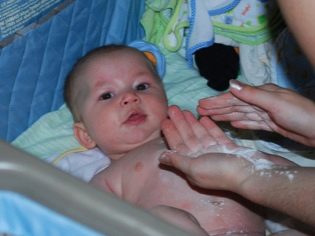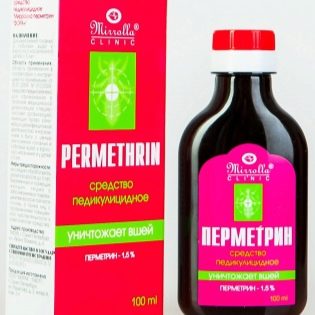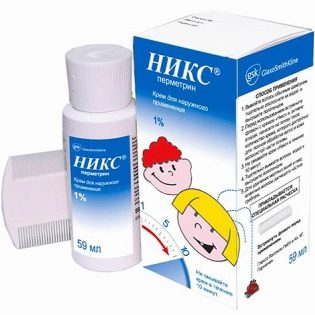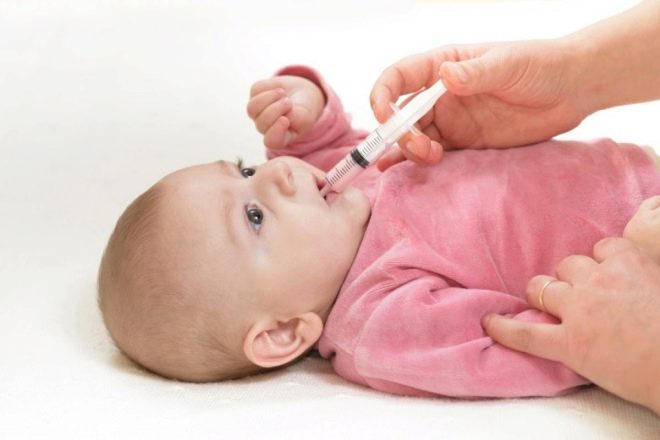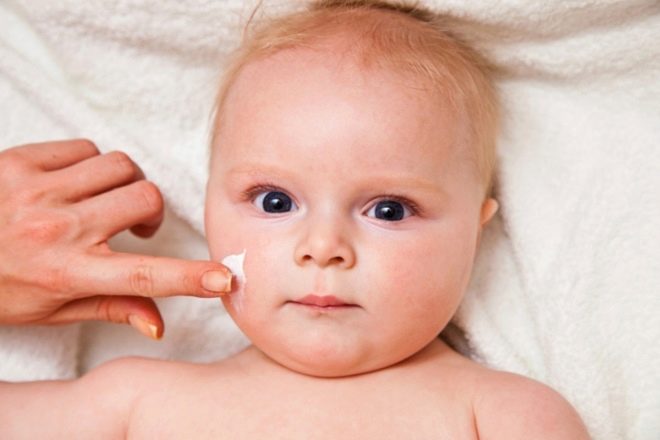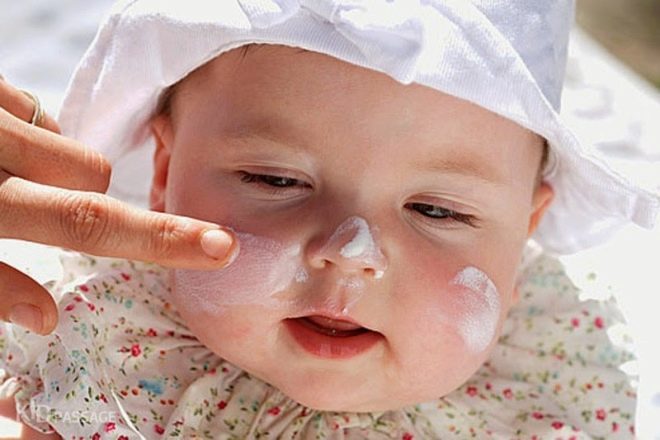What if there is a rash in a newborn or baby?
Every mother wants to see a newborn baby healthy and beautiful, as in the advertising picture. However, reality does not always correspond to bright expectations, and the baby, instead of velvet skin and pink cheeks, does not cease to show her mother more and more new samples of various rashes. What can tell skin rash in an infant, how to understand why a rash appeared and how to treat a baby, we will tell in this article.
Skin features of babies
A child is born with skin that is not adapted to the environment. Baby accustomed to the fact that his nine months surrounded by water. It was practically sterile habitat. In this world, the baby is met by quite aggressive air and a mass of bacteria and other microorganisms that live in humans on the skin.
The load that falls on the skin of the crumbs in the first months after birth, is enormous.
The baby’s skin is thinner, it is almost two times thinner than the skin of an adult, and only by the age of 7, the skin of the child becomes similar to the skin of his parents - in structure, thickness, and biochemical composition. The newborn and the baby are underdeveloped granular layer, and therefore the skin has a certain transparency, the blood vessels are located very close to the surface. That is why babies delight happy new parents with red, pink and even purple skin tones in the first time after birth.
The secret covering crumbs at birth has a neutral balance. Rather, it simply protects the skin from dehydration after an abrupt change in habitat. But such a secret, unfortunately, cannot protect a child from bacteria, fungi and other microorganisms that can cause diseases and rashes. The sebaceous glands are actively working in babies of the first year of life, but many questions arise from the sweat, because their ducts are more than half closed by epithelial cells and the glands cannot fully function.
The main function of the skin is defensive, but it is in infants that it is not sufficiently developed, because from thin and vulnerable skin, which is practically not able to withstand external threats, an unimportant defender is obtained. Thermoregulation, which is also imposed by nature on the skin, is not developed in a child. Only as it grows, the work of the thermoregulation center in the brain will normalize, and with it the skin heat transfer will improve. In the first year of life, the child easily overheats or overcools.
There are their age features in the nerve endings of the skin of babies, and in the subcutaneous fatty tissue. That is why the skin of babies should be treated with great respect and care, in every way helping her adapt.
Careful attention should be paid to the rash, because she always talks about something.
The causeless rash in infants does not happen, there are parents who can not recognize the "signals" of the child's body. Let's learn this.
Causes and symptoms
The causes of a rash on the face and body of a newborn can be very diverse, given that its delicate and thin skin is extremely susceptible to everything that affects it. The most common causes of sudden rashes are:
- allergic reaction (for food, medicines, chemicals and household chemicals, less often for dust or sunlight);
- atopic dermatitis (exposure to allergens with a congenital propensity to inadequate response to protein antigens);
- hormonal "explosions" (a strong effect on the children's organism of the maternal female sex hormones);
- infections (bacterial, viral, fungal);
- violation of hygiene and care (dirt, untimely change of the diaper, overheating or overcooling);
- parasitic diseases (scabies, pediculosis, skin mite).
Allergic rash is the most common. The most likely in infancy is food allergies. The desire of the nursing mother to diversify and enrich their own diet with vitamins and trace elements is understandable and worthy of respect.
But not all substances that enter the breast milk, the child's body is able to digest and absorb. Some proteins that are not yet under the power of children's digestion, enter the intestine in its original state, and simply rot there, causing a violent skin reaction.
After a while, the baby’s immunity begins to react to such protein-antigens, which leads to an autoimmune reaction. If the mother continues to “deliver” the allergen with milk to the baby, then the reaction is enhanced, since the immunity is already “familiar” with these antigens. Skin rashes are often formed in response to an unsuitable child detergent, which is aggressive, to detergent powder, with which the mother removes clothes and bedding, as well as medicines. An allergic rash can affect any part of the body, but most often it occurs on the cheeks, on the chin, on the ears and behind the ears, on the shoulders and tummy.
Atopic dermatitis is always associated with a genetic predisposition to respond to certain triggers.
Inflammatory reactions on the skin provoke microtraumas and standard allergens, which include plant pollen, wool and down of domestic animals and birds, chemical allergens. Chlorine, which is part of ordinary tap water, is especially dangerous. Therefore, at the first signs of atopic dermatitis, all chlorine-containing agents should be excluded, and the water from the tap for bathing and washing will have to be boiled beforehand.
In children under one year, such a disease is manifested by extensive red spots with a rash that itch and give the child a lot of unpleasant emotions. Most often, atopic dermatitis appears on the arms and legs, on the buttocks, on the cheeks, on the neck, on the head. It quickly enough goes into the chronic stage and becomes aggravated every time when an adverse factor affects the child’s body - illness, hypothermia, sweating or contact with something potentially allergenic, for example, with laundry, washed adult laundry detergent, domestic cat, ointments and drugs.
Hormonal rash most often occurs in children in the first weeks after birth. In some children, it manifests itself in a week, in others - in the first six months. However, in the overwhelming majority of cases, rash appears three weeks after birth, so the phenomenon has been called the "three-week rash." Maternal hormones, estrogens, which the baby received in large quantities just before childbirth, when in the mother's body, these hormones began to stand out with shock doses, are to blame. Under the influence of hormones in the skin, the same processes occur as in adolescents in the pubertal period - the sebaceous glands become active, their ducts are narrow, and therefore they quickly become blocked.
Such a neonatal rash for this reason is more often acne. Pimples are localized mainly on the face, on the nose, chin, on the forehead. Acne looks like single pimples with a yellow center, with white heads. Sometimes, ears and neck are also affected, less often - the scalp.When an infection becomes attached, the rash can become pustular, but that’s another story.
Infectious rash is diverse and rich in clinical manifestations. However, she never comes alone, along with her appear (a little earlier or a little later) other symptoms of the disease.
Therefore, if the child has a fever, symptoms of intoxication, cough, runny nose or diarrhea, and at the same time or a little later, a rash appeared, most likely it is about an infection.
Bacterial infections (pyoderma, pustular staphylococcal lesions, furunculosis) most often cause staphylococci that live on the skin of any person, and for the time being "sit" quietly. If the immunity is weakened, the child can not resist the microbes, they penetrate into the microcracks on the skin and cause a variety of the number and size of the rash, the hallmark of which is suppuration. Streptococci cause streptoderma, which is manifested by a red small rash on the arms, legs, face. Each blister is filled with a colorless liquid, after breaking a crust forms.
Fungal lesions appear as fragments of a small rash, strongly delineated, with pronounced boundaries. At the same time, the rash does not contain pus or fluids, it is whitish, rather quickly the skin areas with such rashes begin to dry and peel strongly. Most often, the hands and feet are affected, the scalp, colonies of fungi like to multiply in the eyebrows and eyelids, as well as in the mouth on the mucous membranes (the so-called thrush caused by fungi of the genus Candida).
Viruses do not cause a rash directly, but diseases accompanied by a rash. This is chickenpox, measles, scarlet fever, herpes infection. With each of the diseases, the rash is located in certain places and has its own distinctive signs. So virus herpes the first type is manifested by single rashes around the mouth, on the chin, in the nose.
Sexual herpes manifested in baby rash in the anus, genitals, on the buttocks, on the thighs on the inside. A chickenpox rash can be located all over the body, including the scalp.
With scarlet fever rash covers the crotch, cheeks, armpits, and in roseole, a baby rash appears after three days of temperature, the pink elements are located on the back, abdomen, and chest. A rash on the lower back in the form of a tape may indicate a chronic variant of a herpetic infection; in children of such a young age, it usually is congenital. It is easy to distinguish a viral rash by the onset of the disease - it always begins with a sharp rise in temperature, with possible respiratory phenomena - a runny nose, nasal flow, cough.
Throat and tonsils often react to viruses with an increase and redness, and sometimes a rash appears on them (for example, with herpes sore throat).
Prickly heat and diaper rash, in contrast to all of the above, are only superficial. This inflammation of the epidermis caused by aggressive substances that are contained in the urine, feces, sweat. With inadequate hygiene, prickly heat is commonplace. It is manifested by redness and slight swelling of the skin in the folds, on the bottom, on the genitals, under the arms, in the folds of the arms and legs. In the zone of redness, small red rashes are visible without pus, white heads and signs of peeling.
To distinguish prickly heat from infection or allergies is quite simple. It is necessary for an hour and a half to leave the child naked. Air baths are detrimental to diaper rash. The rash quickly turns pale and disappears, leaving small, dry skin with partially peeling. Neither allergies nor infections from exposure to ordinary air will not pass.
Children who have been swollen tightly in a hot room usually suffer from hemorrhage; usually the rash starts from the spots that sweat the most. Since the thermoregulation of the child is still imperfect, the heat is released through the scalp.Prickly heat, thus, for the most part “starts” at the back of the head.
Not only lack of hygiene, but also its excess can cause such unpleasant skin events. If parents wash the child too often, they use soap or other detergents, even if they are for children, then the protective lipid layer, which is called the mantle is simply washed off and the baby’s skin begins to dry. This leads to a wide variety of skin lesions, and also increases the risk of a fungal or bacterial infection.
Parasites small child can only get from adults who are in contact with him. When a punctate rash appears, located between the fingers, on the hips, on the stomach, it is worth suspecting scabies on the baby. With small dotted rash on the neck and head, pediculosis is not excluded. If the rash is spread to the arms and legs, it is worth examining the baby from an infectious disease specialist or dermatologist for skin mites.
Thoughts of a parasitic skin lesion should visit the parents if the rash resembles insect bites.
The child’s behavior will help them orient themselves, for the parasite’s bites itch and itch very much, cause pain, and therefore the child will be very restless, tearful, anxious and capricious. All of the above reasons are equally relevant for a child in 1 month, and for infants, who will soon be one year old. There are no special age differences, except that the older child can scratch where it itches and the newborn cannot. Therefore, parents of babies should be especially attentive and observant.
Diagnostics
When a baby has a rash, it is advisable to show it to the doctor, because not always inexperienced mom will be able to distinguish allergy from neonatal rash, and viral infection from fungal infection. It is better to call the doctor at home, because in infectious diseases the baby is contagious. When a rash should immediately call a pediatrician:
- With a small red rash, with a watery rash, accompanied by a rise in temperature, runny nose, general weakness of the child.
- When the rash with purulent heads.
- For any type of rash, if it is extensive and covers more than 2% of the baby’s skin.
- Any rash that preceded or occurred immediately after vomiting, diarrhea.
You can go to the clinic yourself at:
- small rash that does not violate the overall health of the baby (body temperature is normal or slightly above normal, no pustules, diarrhea, nausea);
- solitary rash on the scalp, on the face.
You can treat yourself without a doctor only diaper rash and prickly heat, you can also do it yourself if you have a neonatal hormone rash that looks like acne. The location of the rash is also important. So, a rash on the abdomen, back, lower back and inner side of the thighs is always the basis for calling a district pediatrician to a house.
A rash on the neck, in the skin folds and on the back of the head is not so alarming symptom, but the consultation of a specialist in this case does not hurt either. A rash on the pope and face - a reason to review the diet of a nursing mother, as well as to ensure that hygiene is adequate.
Methods of diagnosis of rash in children are extensive. They include general and advanced blood, urine, feces, epidermal scrapings for parasites, fungi, content analysis wheal and acne for the presence and type of bacteria, viruses, serological diagnosis.
Doctors to help find the cause and prescribe adequate treatment:
- pediatrician;
- dermatologist;
- infectious diseases specialist;
- allergist.
Treatment
Treatment of a child's rash should be thoughtful and selective. Some types of dermatological rashes do not need special treatment at all, rather regular systematic care is enough. Before you start a child to smear something with a rash, you should find out exactly what reason led to its occurrence.In most cases, without a doctor can not do. This is important for the treatment to be effective, because different types of dermatological lesions require the use of different medicines and treatment methods.
Allergic rash
After identifying the fact of allergy, it is advisable to conduct a series of allergy tests that will show what the inappropriate reaction appeared to the child. This will help to quickly save the baby from an unpleasant rash and prevent its occurrence in the future.
The main treatment for such a dermatological problem is the cessation of contact with the allergen. However, unfortunately, it is not always possible to identify a specific protein-antigen. In this case, the parents of the baby will be given fairly versatile recommendations for preventing allergic reactions. All foods that may cause allergies should be excluded from the diet of a nursing mother - this is fat cow's milk, eggs, red berries and fruits, nuts, a number of greens (for example, cilantro), citrus fruits.
In any case, an allergy to food is not a reason to wean a baby from the breast. This is a common misconception that is more dangerous than the allergy itself to the mandarin eaten by mom. An artificial child may have to change the mixture he eats for another. Hypoallergenic mixtures are more expensive, but after they start feeding, food allergies usually subside.
Be sure to tell the doctor what medicines the child received, what kind of cosmetic products treated his skin. This will help identify and eliminate external allergens.
The general recommendations include the requirements for the exclusion of any detergents that are not labeled "hypoallergenic".
Of the medications for severe rash or rash of unknown origin, the doctor may prescribe antihistamines to the baby - Suprastin or Loradatin in the age dosage. Effective and drops "Fenistil", approved for use from the first days of life. Rash on the cheeks, the body should not be smeared with fatty creams. With minor lesions, it is generally not recommended to touch it.
After the antigen is eliminated, the rash will disappear rather quickly without local medication. An allergic rash that is complicated by the addition of a bacterial infection needs local treatment. For pustular lesions using ointment with antibiotics.
Atopic dermatitis
When atopic dermatitis treatment is always a whole complex of therapeutic measures. Since atopy is a multifaceted process, the conditions in which a child lives and all external and internal factors that affect it should be reviewed. As with conventional allergies, all potentially dangerous food products are excluded from the diet, carpets and soft toys are taken out of the room where the child lives, as possible accumulators of house dust.
It is important to ensure that the crumb does not sweat, because sweat only enhances the manifestations of atopic dermatitis. The linen and clothes of the child should be made only from natural fabrics and washed with special children's hypoallergenic powders. A child with an atopic red rash cannot be overfed.
Mild forms of dermatitis will require only local treatment, severe - systemic therapy with the intake of drugs inside. Locally, most often prescribed cream and suspension (the so-called talkers): "Triderm", "Elidel"," Tsindol. " If dermatitis does not go away for a long time, the doctor may prescribe a hormonal ointment or cream with a small amount of glucocorticosteroid hormones - “Advantan" or "Elokom". They do not have a systemic hormonal effect on the body, so parents should not be afraid of the terrible word “hormones”.
As with conventional allergies, antihistamines will be given along with calcium supplements, as well as means to activate the immune system, for example, Polysorb.
In the course of treatment, the child must be bathed without soap, but often so that the skin is sufficiently moisturized.
Hormonal rash
Hormonal rash on the face of a month-old baby or child older does not need special treatment. She will pass herself as soon as the body of the crumbs "get rid" of maternal sex hormones. It usually takes from a few weeks to 2-3 months. It is absolutely impossible to squeeze pimples in order to prevent infection of wounds, and also not to leave untouched cosmetic defects to a child for the whole life.
Wipe the skin with alcohol, vodka or any means based on alcohol is also prohibited. This can cause the skin to dry out. A rash on the face of a baby cannot be lubricated with baby cream, ointment with antibiotics or other preparations on a fatty basis, this causes an additional blockage of the sebaceous glands and acne increases. Baby powder is also banned - talc only dries the skin, but does not affect the permeability of the sebaceous ducts.
Any neonatal rash bothers mom more than a child who does not suffer from this eruption or pain, or itching, or other inconveniences. If the mother really wants something to treat the child, you can use a small amount of localized fragments of eruptionsSudokrem". Acne will be less if a nursing mother stops being under stress, because the hormone cortisone, which, when experiencing and having quarrels with dad, is produced in large quantities, getting into breast milk directly affects the condition of the baby’s skin.
But washing with a decoction of pharmacy chamomile, a bath with a string will benefit the baby, if, of course, he does not have an allergy to vegetable substances. In any case, this question should be addressed to the attending pediatrician, if he approves, fito-baths can be conducted every evening with courses for no more than 2 weeks in a row.
Infectious rash
Treatment of a bacterial rash is initiated when laboratory analysis for bacposa is ready, which gives the doctor an idea of which microbe caused the lesion and which antibiotics it is sensitive to. Treatment depends on what kind of disease caused staphylococcus or streptococcus. In most cases, there is enough topical application of antiseptics and ointments with antibiotics.
Bacteria are not afraid of alcohol, so children do not need to be treated with vodka and alcohol-containing drugs.
As an antiseptic prescribed "Miramistin"," Chlorophyllipt ". Staphylococcus, for example, is afraid of "Zelenka", and Streptococcus does not like another aniline dye - "Fukortsin". The choice of ointment is the task of the doctor. The most frequently used in pediatric practice "Baneocin"," Erythromycin ointment ","Levomekol».
With extensive bacterial infection, in addition to skin treatments, the child may be prescribed antibiotics inside. Most often, preference is given to penicillin antibacterial drugs enhanced with clavulanic acid - “Amoxiclav", eg. If the bacterium is of hospital origin (the child has become infected in the maternity hospital or in the children's hospital), then such a microbe is quite difficult to destroy, for treatment use stronger antibiotics - cephalosporins and macrolides. Simultaneously with antimicrobial treatment, the baby is prescribed drugs that contain live, beneficial bacteria in order to avoid dysbiosis - Bifiform, Bifidumbacterin.
Rash caused by viral infections, does not need a separate treatment. It passes as the child recovers from the underlying disease. But in order to prevent the accession of a secondary bacterial infection, local antiseptics may be prescribed. The use of drugs requires the majority of herpes virus diseases. Virus simple herpes, chickenpox, cytomegalovirus infection, roseola, genital herpes perfectly treatable "AcyclovirLocal
Fungal lesions require the longest and most thorough treatment.For this, antifungal ointments are prescribed, and sometimes antifungal drugs orally. After a two-week course, a short break is taken, and then the course is repeated to prevent the survival of individual members of the fungal colony.
Prickly heat and diaper rash
With chills and diaper rash, it is important to reconsider the approach to baby hygiene. Do not bathe it in too hot water, the use of soap is minimized. It is important that the child does not appear new fragments of rash from the heat. Therefore, the room should set the optimal parameters for normal heat transfer to the toddler.
The air temperature should not exceed 20-21 degrees, and the humidity should be in the range of 50-70%. Air baths are very useful for the child, so most of the time, while he is awake, it is best to hold naked.
Treat the affected skin after evening bathing and in the morning after waking up. If necessary, you can enter additional processing in the afternoon. With the use of medicines is not necessary to hurry. Most often, women can cope by improving the skin care of the child.
For bathing once a day, they use decoctions of a train or chamomile, they are added to water whose temperature does not exceed 37 degrees Celsius. After bathing, the skin folds and places where there is a rash are lubricated with means that “dry” the skin. Baby cream is not suitable, it is designed to moisturize.
For the treatment of diaper rash, you can use "Sudokrem», «Bepanten", Cream" Weleda ". In case of strong diaper rash, it is possible to apply a small amount of zinc ointment or zinc cream to the affected area for a short time. Well help cream "Desitin" and "Dexpanthenol».
For prickly heat, you can use baby powder, but this should be done with great care, be sure to monitor the skin's response to the application of talcum powder. If a baby begins to form a dry crust at the site of diaper rash under the influence of powder, there is a probability of cracking and infection by bacteria, it is better to refuse powder.
It is not necessary to smear the heat on the head on the head. It passes immediately after parents normalize the air temperature in the room to the optimum values. In this case, it is advisable not to wear a child in a cap, let the scalp "breathe" is the best treatment for diaper rash.
To eliminate prickly heat in the area of the external genital organs and the priests use the above remedies - ointments, creams and powder. In addition, the child chooses high-quality diapers with aloe balm or chamomile oil. Change diapers should be more than usual, avoiding prolonged contact with the already affected skin with urine and feces.
Skin parasites
If skin parasites are found in a child, treatment is prescribed by a doctor depending on which parasites caused the rash and irritation. When scabies baby forbidden to bathe throughout the course of treatment. The most effective drugs for the elimination of itch itch - "Permethrin", "Spregal", "Benzyl benzoate". They put the child on the site of a rash on his stomach and hands, on the hips several times a day and rubbed.
If the rash turns out to be lice bites, then the pediatrician will be able to advise Knicks shampoo with permethrin.
This is one of the few anti-lice drugs allowed for children under one year old. Most pharmacies have an age limit of 2–3 years and older. In any case, when a parasitic disease is detected in a child, the whole family will have to undergo treatment in order to eliminate the source of infection and to prevent re-infection of the baby. Treatment will necessarily require an integrated approach to disinfecting the home, clothing and bedding of all family members and especially the baby’s own things.
Sometimes a skin rash is a result of exposure to substances that enter the child’s blood from internal parasites - helminths. There is no point in treating such a rash separately, as it will appear as long as worms are parasitic in the intestine.Treatment is prescribed by the doctor after receiving the results of the analysis of feces on the worms and eggs of the worm, analysis of scraping from the anus. Usually, treatment takes several days, since modern anti-worming drugs for children mostly need only a single dose.
About what to do with certain types of rash in young children, see the following video.
Prevention
Preventing the appearance of rashes in newborns and children up to a year is in reasonable and competent hygiene, in the proper care of delicate baby skin. There are a few simple rules that will help protect your baby’s skin from possible troubles and illnesses:
- Bathe the newborn every day. However, the use of baby soap is only 1 time in 3-4 days. To wash your hair, you can use soap for children up to a year once a week. This will not allow the skin to dry out.
- Do not rub the baby with a towel. After water procedures lightly blot moist skin, a sufficient amount of liquid should remain in it.
- Be sure to wipe the baby’s skin with wet wipes, after massage using oils. A large amount of fat makes it difficult to "breathe" the skin.
- Air baths naked, arrange a child every day.
- Do not apply ointments and creams, as well as cosmetics that are not intended for use at an early age, even if they are excellent for adults and older children.
- Maintain optimum temperature and the humidity in the room where the baby lives.
- Do not do home cleaning with household cleaning products.incorporating chlorine.
- To have healthy skin, a child must eat right. Any experiments moms with lure can result in the appearance of a rash.
Introducing complementary foods is desirable in a timely manner, in accordance with the calendar of complementary foods.
- The child needs to be vaccinated on time from dangerous infections. Terms of vaccinations are indicated by the National immunization schedule, it is not necessary to violate them.
- Treatment prescribed by a doctor. Allergic, infectious and parasitic rashes cannot and should not be treated with folk remedies. This is a rule that parents should remember as a multiplication table.
- When caring for problem skin, you should adhere to the "gold" standard Dermatology - all that is wet, you need to dry, and all that is too dry to moisten. Therefore, for eczema and diaper rash, drying ointments and powders are used, and for dry skin, children's cream and other moisturizers are used. If this rule is not followed, it is unlikely to keep the baby’s skin healthy.
- The protective properties of baby skin can be enhanced strengthening the general and local immunity of the crumbs. For general protection are important walking in the fresh air, gymnastics, proper nutrition. For local immunity benefit will go contrast douche and tempering, which can be practiced almost from the very birth of the child, as well as massage and air baths.
- Do not neglect the means of protection especially if you plan to stay baby in the sun. UV protection creams and sprays can be applied to all children who have reached the age of six months.
